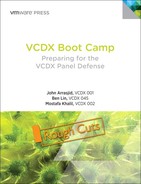Chapter 1. Certification Overview
“An investment in knowledge pays the best interest.”
—Benjamin Franklin
Certification is a strategic weapon for companies, offering technologists the opportunity to achieve higher visibility and marketability while also building a community of identifiable experts. The growth and adoption of virtualization led to extending beyond the well-known VMware Certified Professional (VCP) certification. Development of the VMware Certified Design Expert (VCDX) program began in 2007, driven by market demand to recognize differentiated skill sets for administrators and architects.
With marching orders to create an exam befitting the most senior VMware architects, the certification team collaborated with a group of VMware Professional Services (PSO) architects to define and scope the eventual program. The assembled team included individuals with a diverse set of architecture design skills. The goal was to identify the skill sets necessary in designing, implementing, and operating a VMware-based virtual infrastructure. The development team included Melissa Tuite, John Arrasjid, Mostafa Khalil, Kamau Wanguhu, Andrew Hald, Mahesh Rajani, Craig Risinger, Duncan Epping, Richard Damoser, Ryan Baker, Russ Henmi, Shridhar Deuskar, and several others. Mark Brunstad currently handles program stewardship, a title previously held by Christen Patterson, and Brian Rice.
To ensure the legal defensibility of the certification, the team gathered in Palo Alto, California, where they received training on psychometric analysis and testing methodology. Psychometrics deal with measuring a candidate through testing and assessments. Ease of localization was also a priority when constructing the question pool, to accelerate broader uptake worldwide.
Candidate validation includes confirming design-level skills during the VCAP Data Center Design (VCAP-DCD) certification exam. An interesting aspect in developing the VCAP-DCD questions was to devise a mechanism to validate design skills through freeform graphical representations in a testing center. Developers created a tool that allowed placement and linkage of multiple objects. Craig Risinger worked to develop the initial test questions to validate a candidate on design, integration, and interoperability skills.
Certification development requires careful coordination and collaboration across multiple teams. One of the most time-consuming aspects is developing the design and troubleshooting scenarios because of the requirement to create a realistic environment based on similar situations experienced by VMware customers and partners. We cover more of the details of these scenarios in Chapter 6, “Design Scenario,” and Chapter 7, “Troubleshooting Scenario.”
If a panel consists of three VCDXs, how were the first VCDXs certified if no panelists existed at the time? It is the classic “chicken or egg” causality dilemma. With live defense requirements, non-VCDX panel members certified the first set of VCDXs to bootstrap the program. The initial panelists invariably achieved certification under the same constraints and guidelines. Each member of the original team had seven panelists to validate and refine the overall defense process. The feedback and intense discussions during the initial panels led to the set of parameters that identifies an individual who has demonstrated a sufficient skill set for developing architectures. The photograph in Figure 1.1 shows first eight who worked on the development of the certification.
Figure 1.1. The first eight VCDX who participated in VCDX program development, shown at VMware Technical Summit 2008 (all VCDX Program Developers): John Arrasjid (#001), Mostafa Khalil (#002), Craig Risinger (#006), Enis Konuk, Melissa Tuite (Certification Program Manager), Andrew Hald (#004), Kamau Wanguhu (#003), Duncan Epping (#007), Richard Damoser (#008), and Mahesh Rajani (#005).
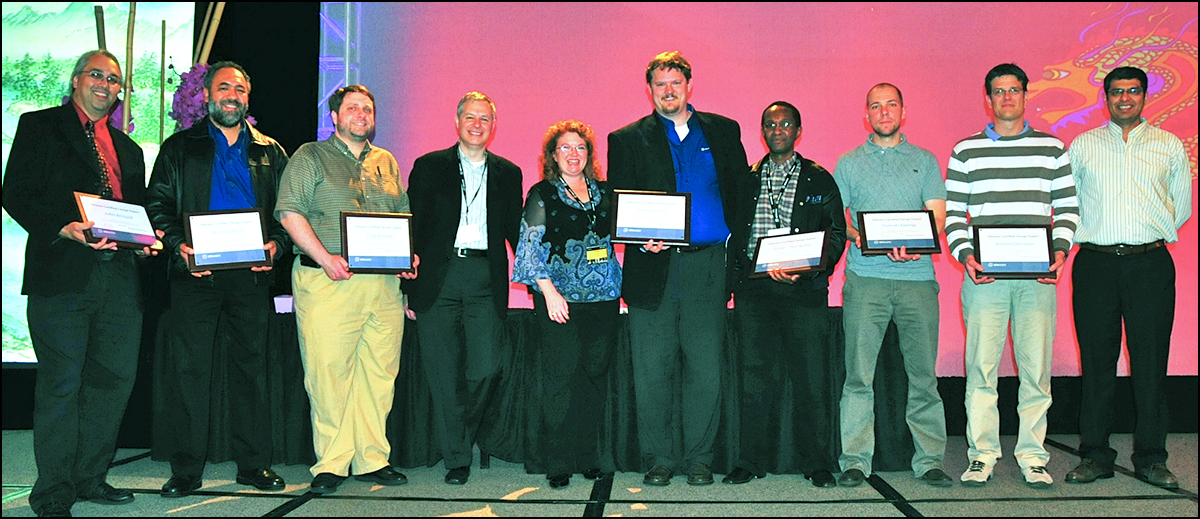
Photo credit: Thomas MacKay (Staff Systems Engineer)
Duncan Epping summarizes his experience:
Back when VCDX was just released, Richard Damoser and I were the first to take the defense (after the original five developed and tested the concept). We did not know what to expect and were nervous for the unknown, but were also overly prepared. I took the exam in San Francisco during an internal training event and was still jet-lagged—and had slept for four hours in three days. That did not help. After every part of the defense, we were asked to leave the room; the panel members would decide if it even made sense to continue. If the panel felt there was no point in continuing, the defense would stop at that time. Even after the 15-minute presentation I prepared, I had to leave the room so that the panel could discuss my defense. Those ten minutes of waiting between the parts were killing, and I am glad those were taken out quickly, as a result of the feedback of those defending that first week. I know my design was far from perfect, but that was no problem, as I had justification for it—some political, but most technical. That same week, during an award dinner, I had the honor to go up on stage and receive my certificate.
VMware Certification Program Framework
Although this book is geared toward individuals preparing for the final stages of VCDX certification, it is important to understand that other certifications are prerequisites. We apologize in advance for the flood of acronyms in this chapter!
VMware certifications fall into separate solution tracks with multiple achievement levels:
• Professional level: VCP (VMware Certified Professional)
• Advanced Professional level: VCAP (VMware Certified Advanced Professional)
• Expert level: VCDX (VMware Certified Design Expert)
• Associate level: VCA (VMware Certified Associate)
Solution tracks include Datacenter Virtualization, End User Computing (desktop), Cloud, and Cloud Application Platform. Newer certifications under development are role based, with the content matched to job roles that include engineering, administration, architecture, development, and governance/operations. Note that the VMware VCA is not a requirement in the VCDX program.
First, let us look at the original path for VCDX that has developed into the VCDX-DV, covering data center virtualization. This path involves validation of vSphere technology skills, administration skills, and design skills through several stages of certification and a live panel defense (see Figure 1.2).
Figure 1.2. Example Datacenter Virtualization (VCDX-DV) certification path.
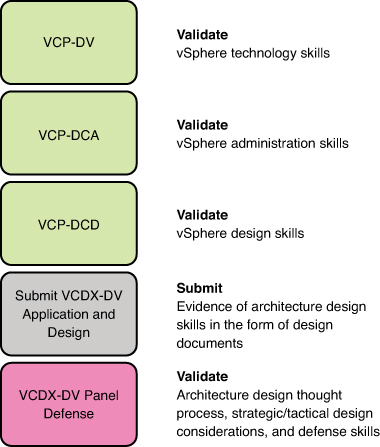
VMware Certified Professional—Datacenter Virtualization (VCP-DV) is the foundational VMware certification that focuses on technology, features, and operations of VMware vSphere.
VMware Certified Advanced Professional (VCAP) for vSphere offers certifications for various career tracks. The VCAP-DCA (Datacenter Administrator) leverages a remote lab to validate the hands-on skills administrators require. The VCAP-DCD (Datacenter Design) tests architecture skills and includes several design questions leveraging a custom modeling tool. Both VCAP-DCA and VCAP-DCD are required for the VCDX certification and can be completed in any order.
VMware Certified Design Expert (VCDX) is the highest level of VMware certification. This group comprises design architects highly skilled in architecture design who have demonstrated their expertise in designing VMware solutions.
Tips for the written exams:
• Review the blueprint. All content on the tests comes from the referenced materials in the test blueprint. Reading through the content might seem tedious, but you will be better prepared to take the exams. If you feel completely outmatched, consider taking a VMware education offering.
• Set a date. Imposing a date constraint provides motivation to work toward gaining the necessary experience to pass the exam. Fear of failure often contributes to procrastination and lack of progress.
• Manage your time. As with any standardized testing, allocate enough time to work through all the test questions. Do not fall into the trap of spending too much time on a single problem. The exception is the VCAP-DCD, where you should prioritize the design questions because of their higher weight.
• Focus on feedback. If you fail an exam, review the scoring to understand which areas require deliberate practice. Knowing what you don’t know is the first step toward improvement.
VCDX Certification Tracks
Each solution track provides a progression from entry level, to the advanced professional level, and finally to the expert level.
Figure 1.3 illustrates the paths toward VCDX certification in the different VCDX solution tracks. The content is described broadly to provide guidance that applies to each track. Rules of inheritance enable a VCP in any track (Cloud, DV, or DT) to sit for any DCD exam and achieve the underlying VCP certification for that track. For example, someone with VCP-Cloud could take the VCAP-DCD exam and achieve both results in VCP-DV certification through inheritance.
Figure 1.3. Pathways to VCDX certifications.

Any VCP-level exam qualifies a candidate to sit any VCAP-level exams. Current VCDX holders in good standing may bridge to additional VCDX certifications by completing a two-step process. The first step is to complete both associated VCAP-level exams. The second step is to submit an application. When the application is accepted, the additional VCDX certification is awarded. All underlying certifications in the associated Solution Track are granted through the rules of inheritance.
The VCP-level certification has a prerequisite class, whereas the other certifications require VCP achievement. Check the VMware certification site for the full list of requirements. Each track has several related dependencies.
TIPS for VCAP-DCA test:
1. Review the blueprint—all possible test items are there (and more).
2. Get in the lab, there is no substitution.
3. Complete the “creation” items first. These are fairly straightforward and simple. Make sure you do not skip any steps, because the test builds out sequentially. If dealing with long-running tasks (that is, maintenance mode), work on other questions in parallel.
4. Focus on completing all tasks in which you have experience. If you have no clue about a particular item (that is, powerCLI scripting) go ahead and skip it. A perfect score is not required to pass.
5. Spend time on the troubleshooting items at the end. These require a bit more thought and tend to take up quite a bit of time.
VCDX for Datacenter Virtualization (VCDX-DV)
VCDX for Datacenter Virtualization focuses on the core VMware virtualization technologies. VCP-DV is the entry-level certification, with VCAP-DCA and VCAP-DCD at the advanced professional level. VCDX-DV is the final certification representing the expert level.
Table 1.1 shows the level, the certification exam, the prerequisites, and recommended classes for each level of the Datacenter Virtualization (DV) track. The VCP-DV level is the only one that requires a class before taking the exam.
Table 1.1. Datacenter Virtualization Track
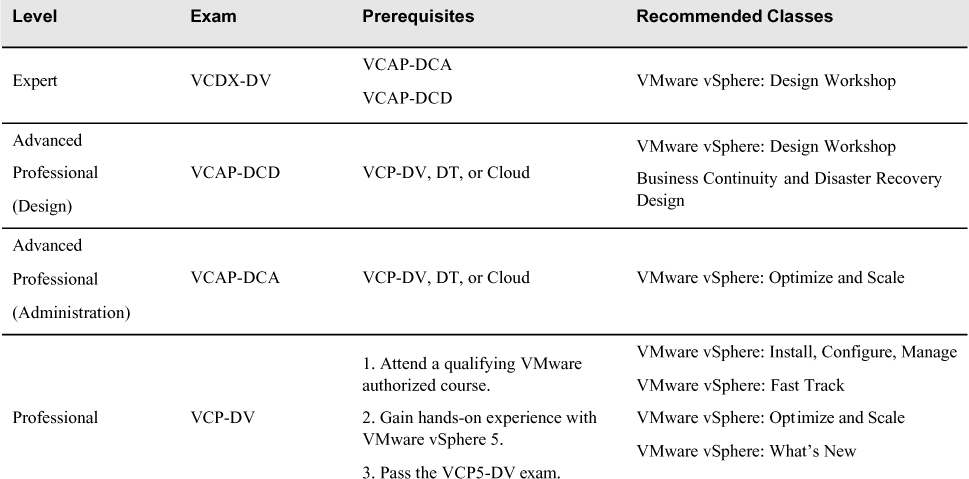
VCDX for Desktop (VCDX-DT)
VCDX for Desktop focuses on the core technologies supporting desktop virtualization. A core component of this is the VMware View environment and the ThinApp technology. VCP-Desktop is the entry-level certification, with VCAP-DTA and VCAP-DTD at the advanced professional level. VCDX-DT is the final certification at the expert level.
Table 1.2 shows the level, the certification exam, the prerequisites, and recommended classes for each level of the desktop (DT) track. The VCP-DT level is the only one that requires a class before taking the exam.
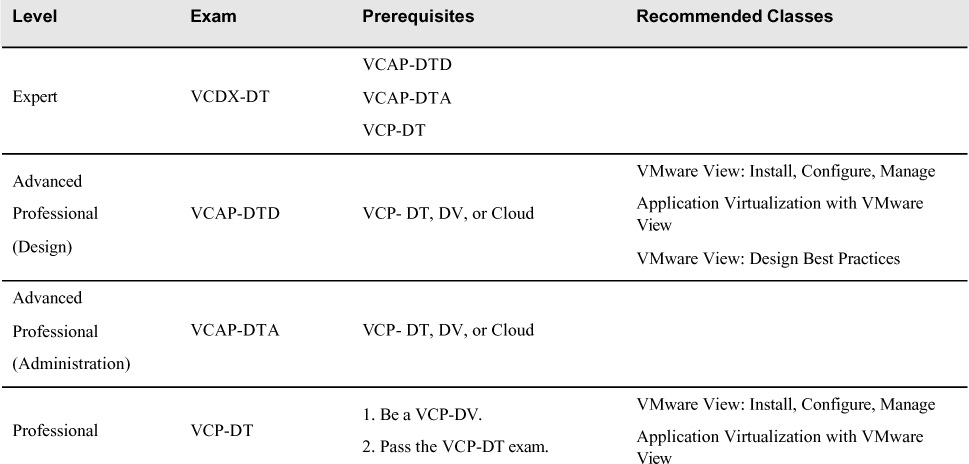
Mock exams are essential in preparation and are recommend for evaluating your readiness before you take the real exam. Mock exams are available at http://www.vmware.com/certification.
VCDX for Cloud (VCDX-Cloud)
VCDX for Cloud focuses on the core technologies supporting cloud solutions. A core component of this is the VMware vCloud Suite. VCP-Cloud is the entry-level certification, with VCAP-CIA and VCAP-CID at the advanced professional level. VCDX-Cloud is the final certification at the expert level.
Table 1.3 shows the level, the certification exam, the prerequisites, and recommended classes for each level of the cloud track. The VCP-Cloud level is the only one that requires a class before taking the exam.

The VCDX Process
After completing the prerequisite exams and gaining experience in creating designs for customers, you are ready to apply for the VCDX. The first step is to submit an application form for a scheduled panel defense. The flowchart in Figure 1.4 shows the sequence of events that can occur based on various outcomes.
Figure 1.4. VCDX certification workflow
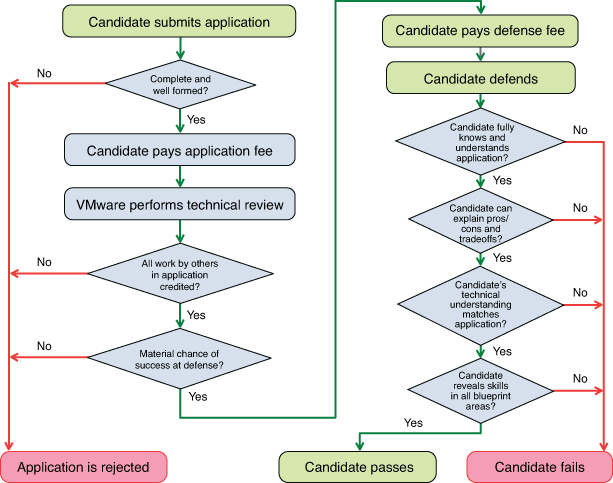
Initial diagram by Brian Rice
When selecting a design, ensure that it is complex enough to support your depth and breadth of knowledge. A design for a small development environment with no SLAs might be technically sound, but it is less likely to reveal how a candidate can design for specific requirements and constraints. This is the reason the blueprint suggests a design that is suitable for business-critical applications in a production environment. No explicit sizing requirements exist, but consider that a 2-host cluster design does not allow for the same scoring opportunities as an 8- to 16-host cluster design with specific SLAs.
When the design and supporting documents such as the test plan and operational procedures are complete, you must complete the application. The VCDX blueprint and the VCDX handbook and application provide the requirements and full instructions for your submission. Additional details on how to complete the application are covered later in Chapter 2, “Preparation.”
Application deadlines are set in advance of the actual defense dates. This provides enough time for both the initial application review and subsequent in-depth panelist reviews. Panelists review your materials and create a list of questions for use during the defense.
VCDX Value Proposition
Achieving VCDX certification has intrinsic and extrinsic benefits, depending on your motivation. Monetary or increased social media presence might be your main objective. Introspection of design skills could be another. Most commonly, you might be looking to challenge yourself. Whatever the case, most people who have gone through the process have found it to be a worthwhile learning experience.
Validating your capabilities to plan and design a VMware solution has tangible benefits to your career in terms of marketability, credibility, and compensation.
Benefits for VCDX holders include the following:
• VCDX certificate
• VCDX logo wear
• Use of the VMware Certified Design Expert logo on business cards and website
• Biography featured in the VCDX directory on VMware.com
• Discounted admission to VMware events
• Invitation to participate in beta classes and exams
• Invitation to participate in special events at VMworld-sponsored conferences
• Participation in VCDX communities
• Participation in the VCDX advisory board
• Additional benefits that may be one time or recurring, as defined by VMware
Wade Holmes (VCDX 15) talks about how achieving VCDX was just a starting point:
Since joining VMware, my participation in the VCDX program has only helped to hone my skills as a virtualization and cloud architect. It has forced me to sharpen my understanding of enterprise architecture principles, principles that aid me greatly in my day-to-day role dealing with virtualization and cloud solutions. I will be forever grateful to the VCDX program in providing a vehicle that forced me to push myself and aiding me to take my career to another level.
Review
VMware’s certification framework is organized along three solution tracks (Datacenter Virtualization, Desktop, and Cloud) and has four levels: Associate, Professional, Advanced Professional, and Expert. Individuals who validate their skills by embarking on a certification path typically benefit from the recognition associated with achieving a particular level of certification. Certification requirements are subject to change. Visit http://www.vmware.com/certification for the most up-to-date information.
